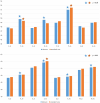Health-related quality of life and self-care in heart failure patients under telecare-insights from the randomized, prospective, controlled AMULET trial
- PMID: 39391161
- PMCID: PMC11465234
- DOI: 10.3389/fpubh.2024.1431778
Health-related quality of life and self-care in heart failure patients under telecare-insights from the randomized, prospective, controlled AMULET trial
Abstract
Introduction: The growing population of heart failure (HF) patients places a burden on the healthcare system. Patient-centered outcomes such as health-related quality of life (HRQoL) and self-care behaviors are key elements of modern HF management programs. Thus, optimized strategies to improve these outcomes are sought.
Purpose: To assess the effects of a new model of medical telecare on HRQoL and self-care in patients with HF (the AMULET study).
Methods: The study was prospective, randomized, open-label, and controlled with two parallel groups: telecare and standard care. In the telecare group, HF nurses performed patient clinical assessments with telemedical support by a cardiologist and provided education focused on the prevention of HF exacerbation. In the standard care group, patients were followed according to standard practices in the existing healthcare system. At the baseline and at 12 months, HRQoL was assessed using the Short Form 36 (SF-36) questionnaire and the Minnesota Living with Heart Failure Questionnaire (MLwHF). The level of self-care was assessed with the 12-item standardized European Heart Failure Self-care Behavior Scale (EHFScBS-12).
Results: In the overall study group, 79% of the subjects were male, the mean age was 67 ± 14 years, and 59% of the subjects were older than 65 years of age. The majority of the subjects (70%) had a left ventricular ejection fraction below 40%. After 12 months, statistically significant increases in physical component of the SF-36 (43.3 vs. 47.4 for telecare vs. 43.4 vs. 46.6 for standard care) and mental component of SF-36 (58.4 vs. 62 for telecare vs. 60.4 vs. 64.2 for standard care) were noted, with no intergroup differences. However, patients receiving telecare showed improvement in specific domains, such as physical functioning, role-physical, bodily pain, vitality, social functioning, role-emotional, and mental health. There was a significant decrease in MLwHF (29 vs. 35.0; lower is better) at follow-up for both groups. Telecare patients had a statistically significant decrease in EHFScBS-12 (lower is better) at 12 months.
Conclusion: AMULET outpatient telecare, which is based on nurse-led non-invasive assessments supported by specialist teleconsultations, improved the HRQoL and self-care of HF patients after an episode of acute HF.
Keywords: health-related quality of life; heart failure; heart failure management; self-care; telecare.
Copyright © 2024 Piotrowicz, Krzesiński, Galas, Stańczyk, Siebert, Jankowska, Siwołowski, Gutknecht, Murawski, Szalewska, Banasiak, Ponikowski and Gielerak.
Conflict of interest statement
The authors declare that the research was conducted in the absence of any commercial or financial relationships that could be construed as a potential conflict of interest.
Figures





References
-
- Conrad N, Misra S, Verbakel JY, Verbeke G, Molenberghs G, Taylor PN, et al. . Incidence, prevalence, and co-occurrence of autoimmune disorders over time and by age, sex, and socioeconomic status: a population-based cohort study of 22 million individuals in the UK. Lancet. (2023) 401:1878–90. doi: 10.1016/S0140-6736(23)00457-9 - DOI - PubMed
-
- Koehler F, Koehler K, Deckwart O, Prescher S, Wegscheider K, Kirwan BA, et al. . Efficacy of telemedical interventional management in patients with heart failure (TIM-HF2): a randomised, controlled, parallel-group, unmasked trial. Lancet. (2018) 392:1047–57. doi: 10.1016/S0140-6736(18)31880-4, PMID: - DOI - PubMed
Publication types
MeSH terms
LinkOut - more resources
Full Text Sources
Medical
Research Materials
Miscellaneous

